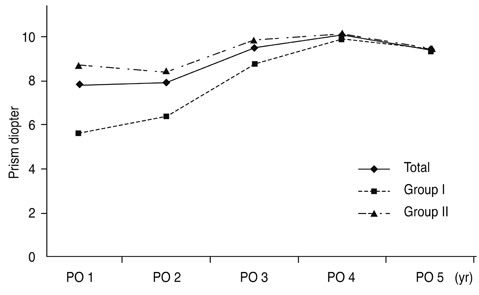Korean J Ophthalmol.
2012 Dec;26(6):446-450. 10.3341/kjo.2012.26.6.446.
Postoperative Stabilization of the Strabismic Angle in Intermittent Exotropia
- Affiliations
-
- 1Department of Ophthalmology, Korea University College of Medicine, Seoul, Korea. ansaneye@hanmail.net
- KMID: 1499683
- DOI: http://doi.org/10.3341/kjo.2012.26.6.446
Abstract
- PURPOSE
To analyze the postoperative strabismic angle for five years or more and to investigate when the angle stabilized in intermittent exotropia.
METHODS
We retrospectively reviewed the clinical records of 89 patients who had undergone surgery for intermittent exotropia. The postoperative strabismic angles measured were analyzed at one-year intervals up to five years postoperatively. We divided them into two groups according to their age at the time of surgery. Group 1 was less than 5 years of age, while Group 2 participants were 5 years of age or older.
RESULTS
For our 89 total patients, average exo-angles were 7.8 +/- 7.26, 7.9 +/- 7.51, 9.5 +/- 7.05, 10.1 +/- 6.87, and 9.4 +/- 6.90 prism diopters at one, two, three, four, and five years postoperatively, respectively. Average exo-angles between postoperative year one and year three, as well as between postoperative year two and year three, were statistically significant (p = 0.015, 0.022). However, the angles were not statistically significant between postoperative year three and year four or between years three and five, respectively (p = 0.707, p = 0.948). The stabilization characteristics of the angle were somewhat different according to age group. In Group 1, the average exo-angle in postoperative years one and three were statistically significant (p = 0.016), but the angle in the same period was not statistically significant in Group 2 (p = 0.203).
CONCLUSIONS
There was no significant interval change after three years postoperatively in intermittent exotropia, but if the patient's age at surgery was 5 years or higher, no significant change of exo-angle was found following postoperative year one in this study.
MeSH Terms
Figure
Reference
-
1. Burian HM, Spivey BE. The surgical management of exodeviations. Am J Ophthalmol. 1965. 59:603–620.2. Hardesty HH, Boynton JR, Keenan JP. Treatment of intermittent exotropia. Arch Ophthalmol. 1978. 96:268–274.3. Pratt-Johnson JA, Barlow JM, Tillson G. Early surgery in intermittent exotropia. Am J Ophthalmol. 1977. 84:689–694.4. Richard JM, Parks MM. Intermittent exotropia: surgical results in different age groups. Ophthalmology. 1983. 90:1172–1177.5. Stoller SH, Simon JW, Lininger LL. Bilateral lateral rectus recession for exotropia: a survival analysis. J Pediatr Ophthalmol Strabismus. 1994. 31:89–92.6. Maruo T, Kubota N, Sakaue T, Usui C. Intermittent exotropia surgery in children: long term outcome regarding changes in binocular alignment. A study of 666 cases. Binocul Vis Strabismus Q. 2001. 16:265–270.7. Jeoung JW, Lee MJ, Hwang JM. Bilateral lateral rectus recession versus unilateral recess-resect procedure for exotropia with a dominant eye. Am J Ophthalmol. 2006. 141:683–688.8. Chia A, Seenyen L, Long QB. Surgical experiences with two-muscle surgery for the treatment of intermittent exotropia. J AAPOS. 2006. 10:206–211.9. Wu H, Sun J, Xia X, et al. Binocular status after surgery for constant and intermittent exotropia. Am J Ophthalmol. 2006. 142:822–826.10. Ekdawi NS, Nusz KJ, Diehl NN, Mohney BG. Postoperative outcomes in children with intermittent exotropia from a population-based cohort. J AAPOS. 2009. 13:4–7.11. Pratt-Johnson JA, Barlow JM, Tillson G. Early surgery in intermittent exotropia. Am J Ophthalmol. 1977. 84:689–694.12. Parks MM. Berke RN, Haik GM, editors. New Orleans Academy of Ophthalmology. Comitant exodeviations in children. Strabismus: symposium of the New Orleans Academy of Ophthalmology. 1962. St. Louis: Mosby;45.13. Knapp P. Burian HM, editor. New Orleans Academy of Ophthalmology. Management of exotropia. Symposium on strabismus: transaction of the New Orleans Academy of Ophthalmology. 1971. St. Louis: Mosby;233.14. Ju WK, Lee JY. Short-term changes of immediate postoperative deviation after lateral rectus recession for intermittent exotropia. J Korean Ophthalmol Soc. 2006. 47:140–147.15. Edelman PM, Brown MH, Murphree AL, Wright KW. Consecutive esodeviation. Then what? Am Orthopt J. 1988. 38:111–116.16. Scott WE, Keech R, Mash AJ. The postoperative results and stability of exodeviations. Arch Ophthalmol. 1981. 99:1814–1818.17. Hahm KH, Shin MC, Sohn MA. The change in deviation angle with time course after surgical correction of intermittent exotropia. J Korean Ophthalmol Soc. 2002. 43:2214–2219.18. Hatsukawa Y. Short-term and long-term prognosis of recession-resection surgery for exotropia. Nihon Ganka Gakkai Zasshi. 1992. 96:1466–1476.19. Nakagawa T. Long-term results of the intermittent exotropia. J Eye. 1987. 4:1481–1487.20. Kordic H, Sturm V, Landau K. Long-term follow-up after surgery for exodeviation. Klin Monbl Augenheilkd. 2009. 226:315–320.
- Full Text Links
- Actions
-
Cited
- CITED
-
- Close
- Share
- Similar articles
-
- Surgical Outcomes of Intermittent Exotropia as a Function of Strabismic Angle
- The Clinical Characteristics of Intermittent Exotropia and Their Relationship
- The Natural Course in Children with Intermittent Exotropia
- The influence of fusional divergence on the surgical results in intermittent exotropia
- Clinical Study for Risk Factors of Recurrence in Intermittent Exotropia



